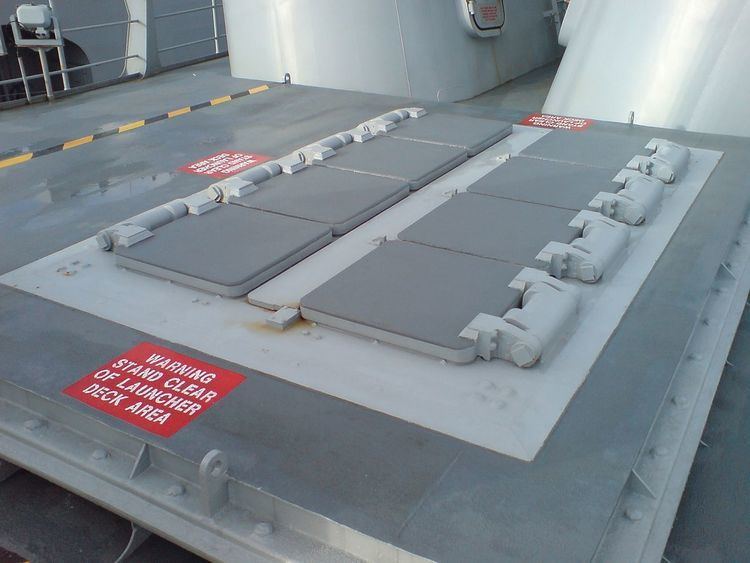In service 1986 – present | Designed 1970s | |
 | ||
Type Missile Launching System Place of origin United States of America Used by United States Navy
and a number of others Wars Cold War
Tanker War
Gulf War
Kosovo War
War on Terror | ||
The Mark 41 Vertical Launching System (Mk 41 VLS) is a shipborne missile canister launching system which provides a rapid-fire launch capability against hostile threats. The Vertical Launch System (VLS) concept was derived from work on the Aegis Combat System.
Contents
History
Refinement of the initial concept of Aegis system in the 1960s continued through the 1960s and 1970s, and the Mk 41 was conceived in 1976. Originally, the system was only intended to fire the RIM-66 Standard missile, but after the United States Navy decided that all VLS had to be capable of firing the Tomahawk missile, with a consequential increase in the height of the Mk 41 to accommodate the larger missile. The prototype for the launcher was tested and evaluated onboard USS Norton Sound (AVM-1). The first operational launcher was installed aboard USS Bunker Hill.
Mark 41
The Mk 41 is capable of firing the following missiles: RIM-66 Standard, RIM-67 Standard, RIM-161 Standard Missile 3, RIM-174 Standard ERAM, RGM-109 Tomahawk, RUM-139 VL-ASROC, RIM-7 Sea Sparrow, and RIM-162 ESSM. The missiles are pre-loaded into "canisters", which are then loaded into the individual "cells" of the launcher. The ESSM is loaded in a quad-pack with 4 missiles in one Mk 25 canister. Launcher cells are fitted to ships in 8 cell (2 rows of 4) modules that share a common uptake hatch (exhaust system) sited between the two rows. Mk 41 VLS adopts modular design concept, which result in different versions that vary in size and weight due to different "canisters" in various modules. The height (missile length) of the launcher comes in three sizes: 209 inches (5.3 m) for the self-defense version, 266 inches (6.8 m) for the tactical version, and 303 inches (7.7 m) for the strike version. The empty weight for an 8-cell module is 26,800 pounds (12,200 kg) for the self-defense version, 29,800 pounds (13,500 kg) for the tactical version, and 32,000 pounds (15,000 kg) for the strike version. Originally, one module would consist of five cells and a collapsible crane for assisting with replenishment at sea, but replenishment of large missiles at sea was later seen as impractical and dangerous, and modules with the cranes fell out of use.
Mk 57
Mk 57 VLS is the development of Mk 41 VLS. Developed by Raytheon, the primary improvement of Mk 57 GMVLS (guided missile vertical launching system) over Mk 41 is its exhaust gas management system that can accommodate new missile designs having up to 45 percent greater rocket motor mass flow rate than that of Mk 41. The unique symmetric geometry of the U-shaped gas management system facilitates the egress of gases, while minimizing flow into witness cells and reversed flow into the active cell. Elimination of a missile deluge system significantly reduces maintenance and personnel requirements, and protects against accidental missile wet-down.
Variants
According to NAVEDTRA 14324, Gunner's Mate, Chapter 7:
